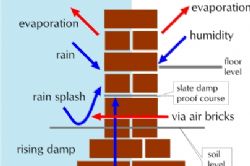
It can sometimes come as a surprise to the newly-arrived expat to find that Spain experiences the 4 seasons, and that the sun isn’t always shinning.
It also rains. A Lot. And where there is rain there is often damp, and the difference between Spanish and British building techniques can sometimes leave a potential buyer wary of how to approach the issue.
Tumbit asked Campbell D. Ferguson, FRICS, of Survey Spain SL to explain how he and his team can assist with the recognition and appraisal of properties which may be affected by damp :
”Imagine you’re looking for a property; see one on the internet; like the look of it – the size, location, specs … even the price. At this point you’re quite excited, so you get in touch with the agent and arrange a viewing. On the appointed day you set eyes on the home ‘in the flesh’ so to speak, and first impressions are favourable, very favourable.
You look around you and could imagine yourself living here, then step through the front door and find yourself liking the interior too. Already, you could see yourself in here, amid your furniture and personal belongings, using this room for that, decorating and changing things to suit your taste. It’s all looking so good, your enthusiasm is rising and you’ve noticed your significant other is feeling the same way. You can also be ‘blinded’ by the view and the current owner’s possessions, plus the homely smell of coffee and baking!
It looks like this could be the one – and then you step into a room and see damp or even a little crack on the wall. Horrors, terror, get your coat and flee. Don’t listen to the mumbled explanations of the agent; just get in the car and drive. Or worse still, the defects are filtered out by your ‘rose-tinted glasses’ and you only find them when the seller’s furniture is removed and you’ve bought the property.
But seriously, need you react so strongly? Although many people fear damp or cracks, there are many kinds and causes, so perhaps you shouldn’t. While it may seem calamitous to the eye, in spite of all the ‘man in the pub’ horror stories we’re told about damp and fungus, collapsed walls and subsidence, very few cases are actually that serious. It’s the cause of the damp that’s important rather than the evidence of damp itself.
But it’s best to make sure
Of course we’ve surveyed a few cases where the damp and/or cracks on a wall are indicative of serious problems, sometimes even impending disaster. Hoping for the best and just ‘plastering over the cracks’, could saddle you with all kinds of very costly problems when those actions don’t work anymore. These range from aesthetic eyesores and cold, humid rooms unfit for habitation to real structural issues.
When you buy a used car you would always have it checked by a qualified mechanic, just to see if problem areas have been skilfully hidden; so it must make even more sense to bring in an expert in building defects when you’re making as big and important a purchase as a property. A house is not something you swap overnight! For most, it is a life changing investment, both on a financial and a personal level, so you have to do it and yourself justice by making sure of things. Buying ‘in good faith’ and trying to get recompense after the event is much more hassle and costly than getting the building checked beforehand.
Equally, a prudent, informed homebuyer will not lose their dream house at the mere sight of a little damp or a bit of cracked plaster. But neither should you ignore evidence like that and simply hope for the best. It could be telling you something important or merely indicate that a little bit of DIY attention is required.
The professional eye of an RICS regulated Chartered Surveyor, trained vocationally and through many years of experience, will immediately get a feel for the issue, inspect the property thoroughly, and look out for these and other telltale signs. A building analysis is an essential part of a property purchase even when you don’t see any mould, moisture or cracks, because it can detect the problems that every house will have, qualify them in terms of seriousness and cost, or indeed tell you what you were hoping to hear and give the property a clean bill of health.
Don’t forget, it isn’t only about the things you can see when you are looking at a property. Some homes that look perfect to the naked eye are ‘hiding’ potentially serious issues, so it is important to see relevant advice from an appropriately qualified professional. With accurate knowledge of the property, you can negotiate with the seller and reduce the price by much more than the cost of the survey!










